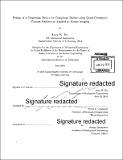Design of a constraint device for compliant bodies using quasi-conformal contact surfaces as applied to mouse imaging
Author(s)
Du, Lucy W
DownloadFull printable version (16.55Mb)
Other Contributors
Massachusetts Institute of Technology. Department of Mechanical Engineering.
Advisor
Martin L. Culpepper.
Terms of use
Metadata
Show full item recordAbstract
The purpose of this work is the modeling and prototyping of quasi-conformal constraint contacts and the investigation of their positioning ability for compliant bodies, specifically for the holding of mice in optical imaging setups. The direct application of this work is the restraint of laboratory mice for biological imaging of micron- and submicron-scale biological structures. No existing research has measured the shear stiffness of mouse facial tissue or modeled the effect of quasi-conformal contact constraints on nonlinear materials. The constraint devices and techniques currently available for mice have limitations that have prevented further exploration of their biological structures. The theoretical model, design rationale, and testing results of a prototype device utilizing quasi-conformal constraints are presented in this thesis. This device is capable of restraining anesthetized mice to sub-micron movement in all axes of translation, without additional surgery or discomfort to the mouse. With the findings presented in this thesis, the design of further optimized devices can be made-both for anesthetized and awake mice-enabling further studies in bone marrow and neural activity that are currently impossible. This could ultimately lead to breakthroughs in stem cell and neurobiological research.
Description
Thesis: S.M., Massachusetts Institute of Technology, Department of Mechanical Engineering, 2016. Cataloged from PDF version of thesis. Includes bibliographical references (pages 99-101).
Date issued
2016Department
Massachusetts Institute of Technology. Department of Mechanical EngineeringPublisher
Massachusetts Institute of Technology
Keywords
Mechanical Engineering.